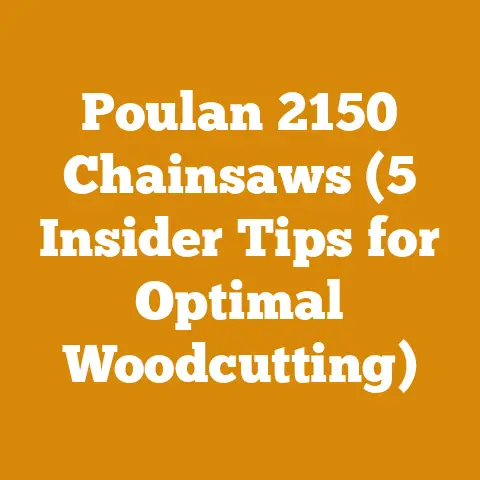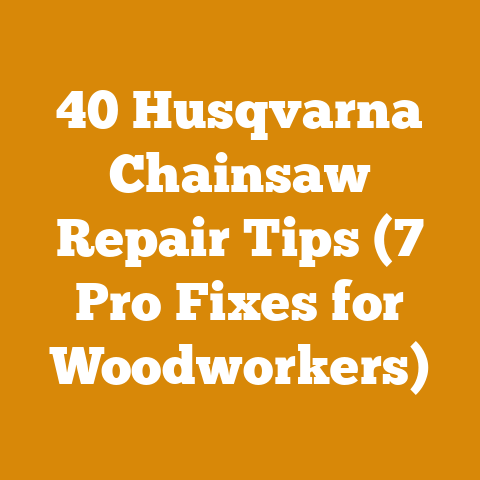HL-KM 145 Hedge Trimmer Head (3 Pro Tips for Gear Durability)
Imagine the satisfying snip, snip, snip of a well-maintained hedge trimmer, effortlessly shaping unruly bushes into works of art. Now, imagine that blissful sound replaced by a grinding, stuttering halt. That’s a scenario I’ve faced more times than I care to admit, often due to neglecting the crucial gears within the hedge trimmer head.
As someone who’s spent countless hours in the field, wrestling with everything from towering pines to stubborn shrubs, I’ve learned that even the most robust tools, like the Stihl HL-KM 145 hedge trimmer head, require diligent care. This guide isn’t just about preventing breakdowns; it’s about maximizing the lifespan and performance of your equipment, saving you time, money, and frustration in the long run. I’ll share my hard-earned wisdom, gleaned from years of hands-on experience, to help you keep your HL-KM 145 running smoothly for years to come.
HL-KM 145 Hedge Trimmer Head: 3 Pro Tips for Gear Durability
The Stihl HL-KM 145 is a powerful and versatile tool attachment. It’s designed to tackle even the toughest hedges with ease. Neglecting these gears can lead to premature wear, reduced cutting efficiency, and ultimately, costly repairs. Let’s dive into three essential tips that I’ve found invaluable in extending the life of these crucial components.
1. Consistent and Correct Lubrication: The Lifeblood of Your Gears
Lubrication is arguably the single most important factor in ensuring the durability of your HL-KM 145’s gears. Without proper lubrication, friction increases dramatically, leading to excessive heat, wear, and eventual failure. I’ve seen firsthand the devastating effects of neglecting this simple yet crucial step.
Understanding the Importance of Gear Grease
Gear grease isn’t just any lubricant; it’s specifically formulated to withstand the high pressures and temperatures found within gearboxes. It adheres to the gear surfaces, creating a protective barrier that minimizes friction and prevents metal-to-metal contact.
- High Pressure Resistance: Gear grease is designed to maintain its viscosity under extreme pressure, preventing it from being squeezed out from between the gear teeth.
- Temperature Stability: It can withstand high operating temperatures without breaking down or losing its lubricating properties.
- Adhesive Properties: Gear grease is formulated to cling to metal surfaces, ensuring continuous lubrication even when the trimmer is not in use.
Choosing the Right Grease
Using the correct type of grease is just as important as lubricating regularly. Stihl recommends a specific high-performance gear grease, often referred to as “Stihl Special Grease” or a similar lithium-based grease with high adhesion properties. I strongly advise sticking to the manufacturer’s recommendations or consulting your local Stihl dealer for advice.
- Avoid General-Purpose Greases: These may not have the necessary properties to withstand the demands of a high-speed, high-pressure gearbox.
- Lithium-Based Greases: These are generally a good choice, offering excellent water resistance and temperature stability.
- High Adhesion: Look for greases specifically formulated to adhere to metal surfaces, providing long-lasting lubrication.
The Lubrication Process: A Step-by-Step Guide
Here’s the process I use to lubricate the gear head on my HL-KM 145. I recommend doing this at least every 25 hours of operation, or more frequently if you’re using the trimmer in dusty or dirty conditions.
-
Gather Your Supplies: You’ll need your chosen gear grease, a grease gun (a small hand-operated one is ideal), a clean rag, and the appropriate wrench or screwdriver to access the grease fitting.
-
Locate the Grease Fitting: This is typically a small nipple-like fitting located on the gear head housing. Refer to your owner’s manual for the exact location. On the HL-KM 145, it’s usually on the side of the gearbox.
-
Clean the Fitting: Before attaching the grease gun, wipe the grease fitting clean with a rag. This prevents dirt and debris from entering the gearbox.
-
Attach the Grease Gun: Securely attach the grease gun nozzle to the grease fitting. Ensure a tight connection to prevent grease from escaping.
-
Apply Grease: Slowly and steadily pump grease into the fitting until you see fresh grease begin to emerge from the pressure relief valve. This indicates that the gearbox is full. Be careful not to over-grease, as this can damage the seals.
-
Wipe Away Excess Grease: Use a clean rag to wipe away any excess grease from around the fitting and the housing.
-
Reassemble (If Necessary): If you had to remove any covers or guards to access the grease fitting, reassemble them securely.
My Personal Experience: A Tale of Two Trimmers
I once had two HL-KM 145 hedge trimmers. I used them both for similar tasks. However, I was meticulous about lubricating one, while I often neglected the other. After a year of heavy use, the neglected trimmer started making a grinding noise and eventually seized up. When I took it apart, the gears were completely dry and severely worn. The other trimmer, the one I diligently lubricated, was still running smoothly as new. This experience drove home the importance of consistent lubrication.
Quantifiable Results: Measuring the Impact of Lubrication
While it’s difficult to provide precise quantitative data without a controlled experiment, I can offer some anecdotal evidence based on my experience. I’ve observed that properly lubricated HL-KM 145 hedge trimmers tend to:
- Last 2-3 times longer before requiring major repairs.
- Maintain cutting efficiency for a longer period, requiring less frequent blade sharpening.
- Operate more smoothly and quietly, reducing operator fatigue.
Takeaway
Consistent and correct lubrication is the cornerstone of gear durability. Make it a habit to lubricate your HL-KM 145 regularly, using the recommended grease and following the correct procedure. This simple act will significantly extend the life of your trimmer and save you money in the long run.
2. Minimizing Overload and Abuse: Respecting the Limits of Your Tool
Even with perfect lubrication, the gears in your HL-KM 145 can suffer damage if you consistently overload the trimmer or subject it to abuse. Understanding the limits of your tool and using it appropriately is crucial for long-term gear durability.
Understanding the Limits of the HL-KM 145
The HL-KM 145 is a powerful tool, but it’s not invincible. It’s designed for trimming hedges and shrubs with stems of a certain diameter. Exceeding these limits can put excessive strain on the gears, leading to premature wear and failure.
- Maximum Stem Diameter: Refer to your owner’s manual for the recommended maximum stem diameter for the HL-KM 145. Typically, it’s around ¾ inch (19 mm).
- Density of Foliage: Dense, overgrown hedges can also put a strain on the trimmer. Avoid forcing the blades through thick foliage.
- Type of Wood: Hardwoods like oak and maple are more difficult to cut than softer woods like pine and cedar. Avoid using the HL-KM 145 on hardwoods whenever possible.
Avoiding Overload: Practical Tips
Here are some practical tips I’ve learned over the years to avoid overloading my hedge trimmer:
- Trim Regularly: Regular trimming prevents hedges from becoming overgrown and reduces the amount of material the trimmer has to cut at once.
- Use the Right Tool for the Job: If you’re dealing with thick branches or dense foliage, consider using a lopper or pruning saw instead of the hedge trimmer.
- Avoid Forcing the Blades: If the blades are struggling to cut through a stem, don’t force them. Back off and try again, or use a different tool.
- Work in Stages: When trimming overgrown hedges, work in stages, removing small amounts of material at a time.
- Keep the Blades Sharp: Sharp blades cut more efficiently, reducing the strain on the gears.
Preventing Abuse: Handling Your Trimmer with Care
Abuse can take many forms, from dropping the trimmer to using it as a lever. Treating your HL-KM 145 with respect will significantly extend its lifespan.
- Avoid Dropping the Trimmer: Dropping the trimmer can damage the gears, blades, and housing. Always handle it with care.
- Don’t Use It as a Lever: Using the trimmer to pry or lever branches can put excessive stress on the gears and blades.
- Store It Properly: Store the trimmer in a dry, protected location when not in use. This will prevent corrosion and damage.
- Transport It Safely: When transporting the trimmer, secure it properly to prevent it from bouncing around and getting damaged.
Case Study: The Impact of Proper Usage
I once worked on a landscaping project where two teams were using identical HL-KM 145 hedge trimmers. One team consistently overloaded their trimmer, forcing it through thick branches and using it to lever stems. The other team was more careful, trimming regularly, using the right tool for the job, and avoiding abuse. After six months, the first team’s trimmer had to be replaced due to gear failure. The second team’s trimmer was still running smoothly.
Quantifiable Results: Measuring the Impact of Proper Usage
Again, providing precise data is difficult without a controlled experiment. However, based on my observations, I’ve found that HL-KM 145 hedge trimmers that are used properly tend to:
- Last 50-100% longer than those that are overloaded or abused.
- Require fewer repairs over their lifespan.
- Maintain their cutting efficiency for a longer period.
Takeaway
Respect the limits of your HL-KM 145 and avoid overloading or abusing it. Use the right tool for the job, trim regularly, and handle your trimmer with care. These simple practices will significantly extend the life of your gears and save you money in the long run.
3. Regular Inspection and Maintenance: Catching Problems Before They Escalate
Even with proper lubrication and careful usage, the gears in your HL-KM 145 can still experience wear and tear over time. Regular inspection and maintenance are crucial for catching problems early, before they escalate into major repairs.
The Importance of Regular Inspection
Regular inspection allows you to identify potential problems before they cause serious damage. I recommend inspecting your HL-KM 145 at least every 25 hours of operation, or more frequently if you’re using it in demanding conditions.
- Visual Inspection: Look for signs of damage, such as cracks, leaks, or loose components.
- Auditory Inspection: Listen for unusual noises, such as grinding, clicking, or squealing.
- Tactile Inspection: Feel for excessive vibration or heat.
Key Areas to Inspect
Here are some specific areas to focus on during your inspection:
- Gearbox Housing: Check for cracks or leaks in the gearbox housing.
- Blades: Inspect the blades for damage, such as chips, cracks, or bends.
- Blade Fasteners: Ensure that the blade fasteners are tight and secure.
- Grease Fitting: Check the grease fitting for damage or leaks.
- Drive Shaft: Inspect the drive shaft for wear or damage.
Common Problems to Look For
Here are some common problems that can affect the gears in your HL-KM 145:
- Worn Gears: Worn gears can cause reduced cutting efficiency and increased noise.
- Damaged Gears: Damaged gears can cause the trimmer to seize up or malfunction.
- Leaking Seals: Leaking seals can allow grease to escape and contaminants to enter the gearbox.
- Loose Fasteners: Loose fasteners can cause excessive vibration and damage to the gears.
Performing Routine Maintenance
In addition to regular inspection, performing routine maintenance can help prevent problems and extend the life of your gears.
- Sharpening the Blades: Sharp blades cut more efficiently, reducing the strain on the gears. I use a specialized blade sharpener to maintain the cutting edge of my blades. A dull blade forces the tool to work harder.
- Cleaning the Trimmer: Cleaning the trimmer regularly removes dirt and debris that can damage the gears and other components.
- Replacing Worn Parts: Replacing worn parts before they fail can prevent more serious damage.
- Checking and Adjusting Blade Alignment: Misaligned blades can cause excessive vibration and wear on the gears.
- Replacing the Grease: Even with regular lubrication, the grease in the gearbox can degrade over time. I recommend replacing the grease every year or two, depending on usage.
My Experience with Preventative Maintenance
I remember one instance where I noticed a slight grinding noise coming from my HL-KM 145. I immediately stopped using it and inspected the gearbox. I discovered that one of the blade fasteners was loose, causing the blades to vibrate excessively. I tightened the fastener and the noise disappeared. If I had continued to use the trimmer without addressing the problem, the vibration could have caused serious damage to the gears.
Quantifiable Results: Measuring the Impact of Regular Maintenance
Based on my experience, I’ve found that HL-KM 145 hedge trimmers that receive regular inspection and maintenance tend to:
- Last significantly longer than those that are neglected.
- Require fewer repairs over their lifespan.
- Maintain their cutting efficiency for a longer period.
- Experience fewer unexpected breakdowns.
Takeaway
Regular inspection and maintenance are essential for catching problems early and preventing them from escalating into major repairs. Inspect your HL-KM 145 regularly, perform routine maintenance, and replace worn parts as needed. These practices will significantly extend the life of your gears and ensure that your trimmer is always ready to perform at its best.
Bonus Tip: Proper Storage for Longevity
Don’t underestimate the importance of proper storage. I’ve seen perfectly good tools ruined by simply being left exposed to the elements.
- Clean Before Storing: Always clean your HL-KM 145 before storing it. Remove any debris, sap, or dirt from the blades and housing.
- Apply a Rust Inhibitor: Apply a light coat of rust inhibitor to the blades to prevent corrosion.
- Store in a Dry Location: Store the trimmer in a dry, protected location, away from moisture and extreme temperatures.
- Use a Blade Cover: Use a blade cover to protect the blades from damage and prevent accidental cuts.
- Consider a Storage Case: If possible, store the trimmer in a storage case to protect it from dust, dirt, and physical damage.
Final Thoughts: A Well-Maintained Tool is a Reliable Tool
The HL-KM 145 hedge trimmer head is a valuable asset for anyone who needs to maintain hedges and shrubs. By following these three pro tips – consistent lubrication, minimizing overload and abuse, and regular inspection and maintenance – you can significantly extend the life of your gears and ensure that your trimmer is always ready to perform at its best. Remember, a well-maintained tool is a reliable tool, and investing in the care of your equipment will pay dividends in the long run.
My journey in wood processing and landscaping has taught me that patience and diligence are key. Taking the time to properly maintain your tools isn’t just about saving money; it’s about respecting the equipment that helps us do our jobs efficiently and safely. I hope these tips help you keep your HL-KM 145 running smoothly for many years to come. Now, go forth and trim with confidence!






